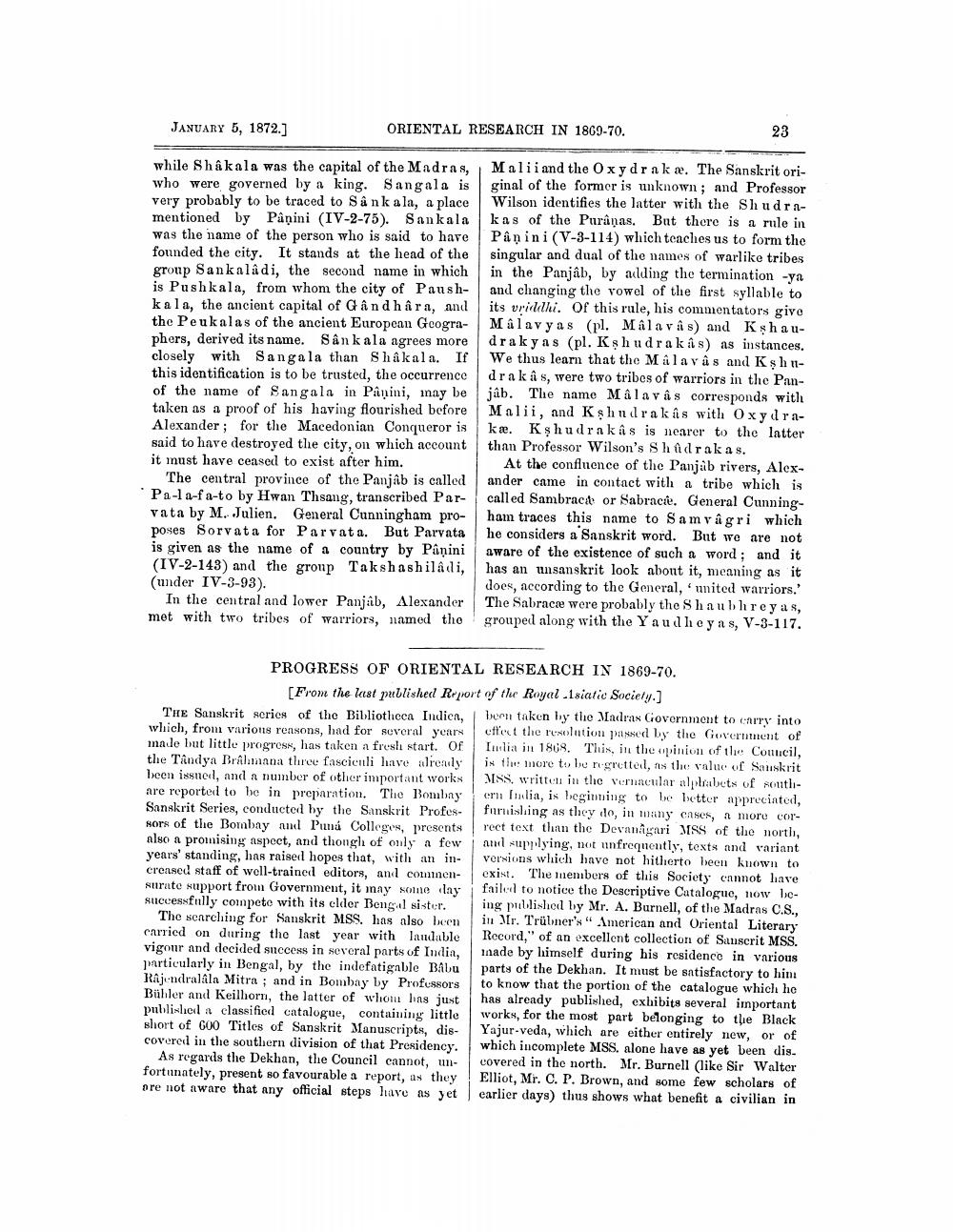________________
JANUARY 5, 1872.]
while Shakala was the capital of the Madras, who were governed by a king. Sangala is very probably to be traced to Sânk ala, a place mentioned by Panini (IV-2-75). Sankala was the name of the person who is said to have founded the city. It stands at the head of the group Sankalâdi, the second name in which is Pushkala, from whom the city of Paushkala, the ancient capital of Gândhara, and the Peukalas of the ancient European Geographers, derived its name. Sân kala agrees more closely with Sangala than Shakala. If this identification is to be trusted, the occurrence of the name of Sangala in Pâini, may be taken as a proof of his having flourished before Alexander; for the Macedonian Conqueror is said to have destroyed the city, on which account it must have ceased to exist after him.
ORIENTAL RESEARCH IN 1869-70.
The central province of the Panjab is called Pa-la-fa-to by Hwan Thsang, transcribed Parvata by M. Julien. General Cunningham proposes Sorvata for Parvata. But Parvata is given as the name of a country by Pânini (IV-2-143) and the group Takshashiladi, (under IV-3-93).
In the central and lower Panjab, Alexander met with two tribes of warriors, named the
THE Sanskrit series of the Bibliotheca Indica, which, from various reasons, had for several years made but little progress, has taken a fresh start. Of the Tândya Brahmana three fasciculi have already been issued, and a number of other important works are reported to be in preparation. The Bombay Sanskrit Series, conducted by the Sanskrit Professors of the Bombay and Puná Colleges, presents also a promising aspect, and thongh of only a few years' standing, has raised hopes that, with an increased staff of well-trained editors, and commensurate support from Government, it may some day successfully compete with its elder Bengal sister.
The searching for Sanskrit MSS. has also been carried on during the last year with landable vigour and decided success in several parts of India, particularly in Bengal, by the indefatigable Babu Rajendralâla Mitra; and in Bombay by Professors Bühler and Keilhorn, the latter of whom has just published a classified catalogue, containing little short of 600 Titles of Sanskrit Manuscripts, discovered in the southern division of that Presidency.
PROGRESS OF ORIENTAL RESEARCH IN 1869-70. [From the last published Report of the Royal Asiatic Society.]
As regards the Dekhan, the Council cannot, unfortunately, present so favourable a report, as they are not aware that any official steps have as yet
23
Malii and the Oxydrake. The Sanskrit original of the former is unknown; and Professor Wilson identifies the latter with the Shudrakas of the Purâņas. But there is a rule in Pân ini (V-3-114) which teaches us to form the singular and dual of the names of warlike tribes in the Panjab, by adding the termination -ya and changing the vowel of the first syllable to its vriddhi. Of this rule, his commentators give Mâlavyas (pl. Malavâs) and Kṣhaudrakyas (pl. Kshudrakas) as instances. We thus learn that the Mala vâs and Kshndra kâs, were two tribes of warriors in the Panjâb. The name Mâ la vâs corresponds with Malii, and Kshudrakâs with Oxydrakæ. Kshudrakâs is nearer to the latter than Professor Wilson's Shûdrakas.
At the confluence of the Panjab rivers, Alexander came in contact with a tribe which is called Sambraca or Sabrace. General Cunningham traces this name to Samvâgri which he considers a Sanskrit word. But we are not aware of the existence of such a word; and it has an unsanskrit look about it, meaning as it does, according to the General, united warriors.' The Sabrace were probably the S haubhreyas, grouped along with the Yaudheyas, V-3-117.
been taken by the Madras Government to carry into effect the resolution passed by the Government of India in 1868. This, in the opinion of the Council, is the more to be regretted, as the value of Sanskrit MSS, written in the vernacular alphabets of southern India, is beginning to be better appreciated, furnishing as they do, in many cases, a more correct text than the Devanagari MSS of the north, and supplying, not unfrequently, texts and variant versions which have not hitherto been known to exist. The members of this Society cannot have failed to notice the Descriptive Catalogue, now being published by Mr. A. Burnell, of the Madras C.S., in Mr. Trübner's" American and Oriental Literary Record," of an excellent collection of Sanscrit MSS. inade by himself during his residence in various parts of the Dekhan. It must be satisfactory to him to know that the portion of the catalogue which he has already published, exhibits several important works, for the most part belonging to the Black Yajur-veda, which are either entirely new, or of which incomplete MSS. alone have as yet been dis covered in the north. Mr. Burnell (like Sir Walter Elliot, Mr. C. P. Brown, and some few scholars of earlier days) thus shows what benefit a civilian in




